The Energy Efficiency Directive: requirements come into focus
The European Commission (EC) continues to grapple with the challenges of implementing the Energy Efficiency Directive (EED) reporting and metrics mandates. The publication of the Task B report Labelling and minimum performance standards schemes for data centres and the Task C report EU repository for the reporting obligation of data centres on June 7, 2023 represent the next step on the implementation journey.
Data center operators need to monitor the evolution of the EC’s plans, recognizing that the final version will not be published until the end of 2023. The good news is that about 95% of the requirements have already been set out and the EC’s focus is now on collecting data to inform the future development and selection of efficiency metrics, minimum performance standards and a rating system.
The Task B and C reports clarify most of the data reporting requirements and set out the preferred policy options for assessing data center energy performance. The reports also indicate the direction and scope of the effort to establish a work per energy metric, supporting metrics — such as power usage effectiveness (PUE) and renewable energy factor (REF) — and the appropriate minimum performance thresholds.
Data reporting update
Operators will need to periodically update their data collection processes to keep pace with adjustments to the EED reporting requirements. The Task C report introduces a refined and expanded list of data reporting elements (see Tables 1 and 2).
The EC intends for IT operators to report maximum work, as measured by the server efficiency rating tool (SERT), and the storage capacity of server and storage equipment, respectively, as well as the estimated CPU utilization of the server equipment with an assessment of its confidence level. The EC will use these data elements to assess the readiness of operators to report a work per energy metric and how data center types and equipment redundancy levels should differentiate thresholds.
Table 1. The EED’s indicator values
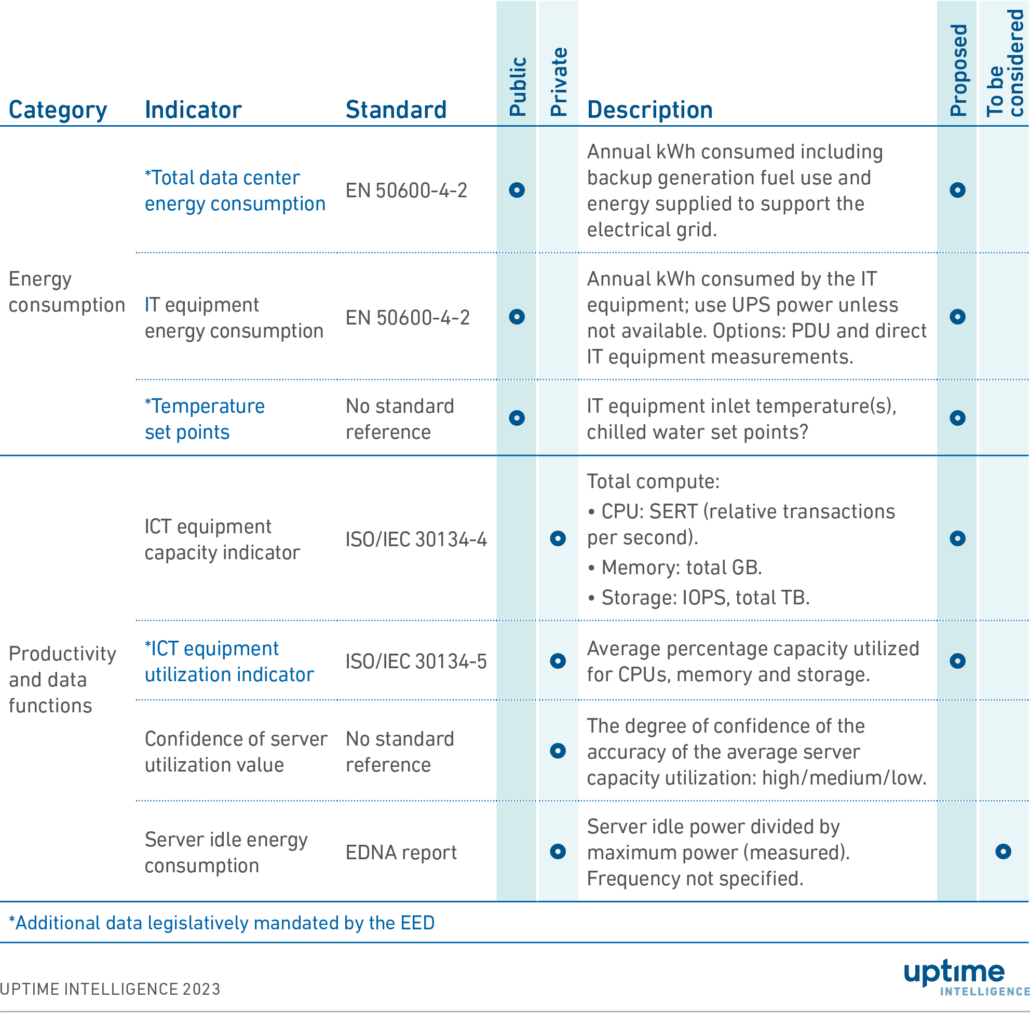
Table 2 describes the new data indicators that have been added to the reporting requirements — water use and renewable energy consumption were listed previously. The Task A report and earlier versions of the EED recast had identified the other elements but had not designated them for reporting.
Table 2. The indicator data to be reported to EU member states
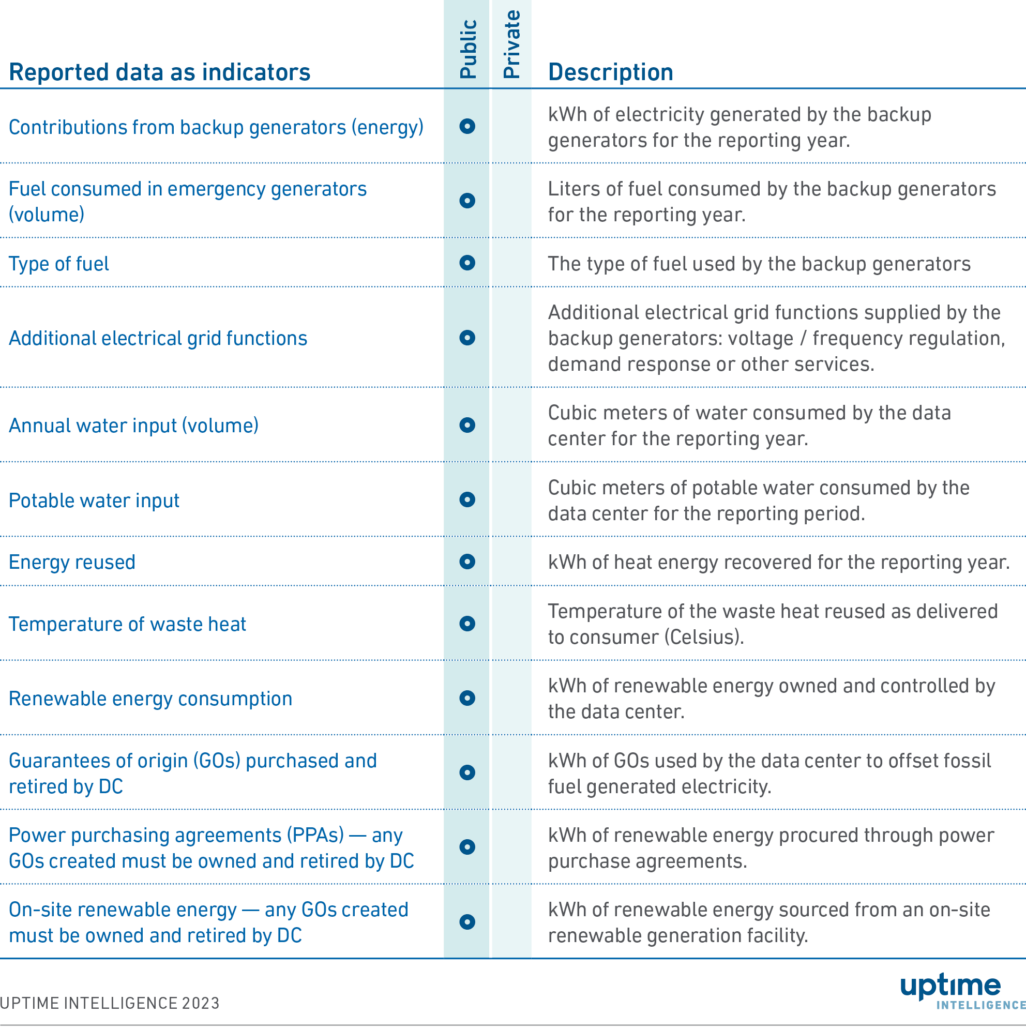
The EC will use these data elements to develop an understanding of data center operating characteristics:
- How backup generators are used to support data center and electrical grid operations.
- The percentage of annual water use that comes from potable water sources. In its comments on the Task B and C reports, Uptime Institute recommended that the EC also collect data on facilities’ cooling systems so that water use and water usage effectiveness (WUE) can be correlated to cooling system type.
- Identify the number of data centers that are capturing heat for reuse and the quality of heat that the systems generate.
- Quantify the renewable energy consumed to run the data center and the quantity of guarantees of origin (GOs) used to offset electricity purchases from the grid. In its comments to the EC, Uptime Institute recommended the use of megawatt-hours (MWh) of renewable or carbon-free energy consumed in the operation, not the combination of MWh of consumption and offsets, to calculate the REF metric.
Section 4 of the Task C report details the full scope of the data elements that need to be reported under the EED. Five data elements specified in Annex VIa of the final EED draft are missing: temperature set points; installed power; annual incoming and outgoing data traffic; amount of data stored and processed; and power utilization. The final data reporting process needs to include these, as instructed by the directive. Table 3 lists the remaining data elements that are not covered in Tables 1, 2 and 4.
Table 3. Other reporting items mandated in the Task A report and the EED
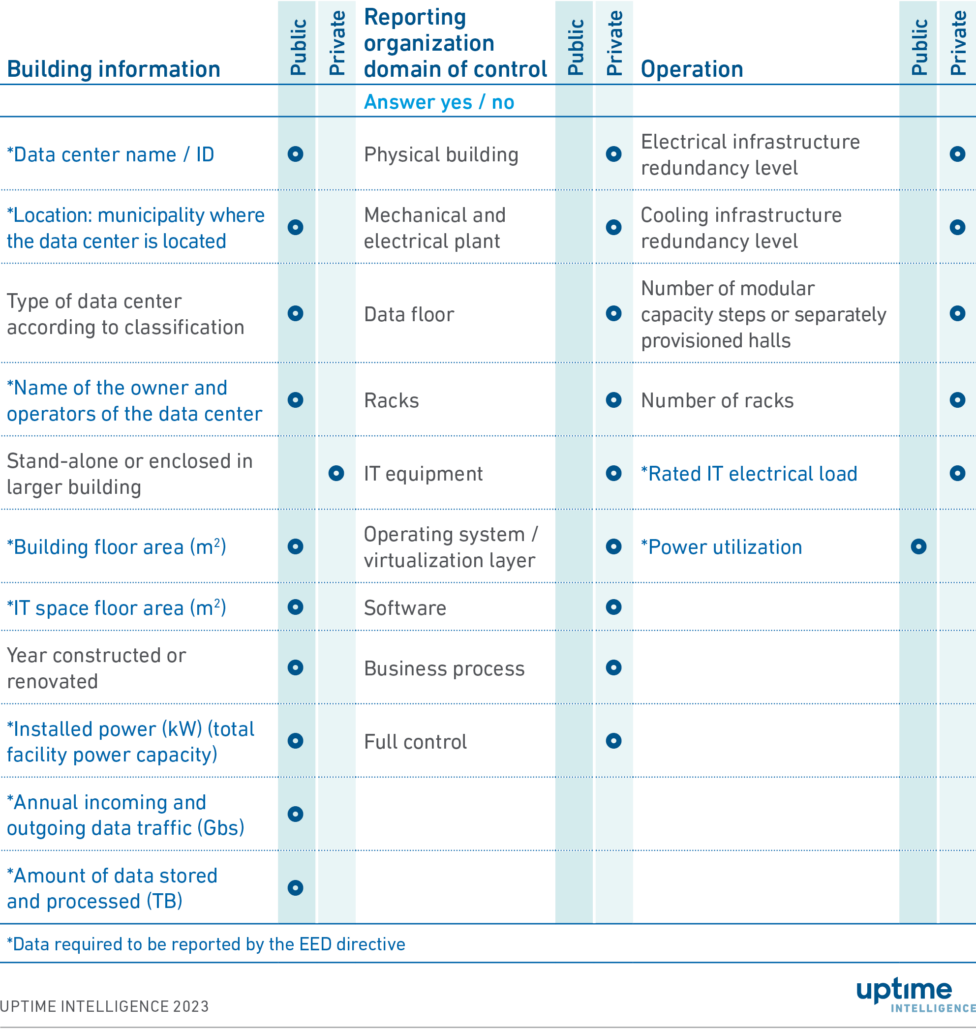
Data center operators need to set up and exercise their data collection process in good time to ensure quality data for their first EED report on May 15, 2024. They should be able to easily collect and report most of the required data, with one exception.
The source of the servers’ maximum work capacity, utilization data, and the methodologies to estimate these values are currently under development. It is likely that these will not be available until the final Task A to D reports are published at the end of 2023. Operators are advised to track the development of these methodologies and be prepared to incorporate them into their reporting processes upon publication.
Colocation operators need to move quickly to establish their processes for collecting the IT equipment data from their tenants. The ideal solution for this challenge would be an industry-standard template that lets IT operators autoload their data to their colocation provider with embedded quality checks. The template would then aggregate the data for each data center location and autoload it to the EU-wide database, as proposed in the Task C document. It is possibly too late to prepare this solution for the May 2024 report, however, the data center industry should seriously consider creating, testing and deploying such a template for the 2025 report.
The reporting of metrics
The EC intends to assess data center locations for at least four of the eight EN 50600-4 metrics (see Table 4). The metrics will be calculated from the submitted indicator data. Task C designates the public reporting of PUE, WUE, REF and energy reuse factor (ERF) by data center location. Two ICT metrics, IT equipment energy efficiency for servers (ITEEsv) and IT equipment utilization for servers (ITEUsv), will be calculated from indicator data but not publicly reported.
The cooling efficiency ratio (CER) and the carbon usage effectiveness (CUE) are not designated for indicator data collection or calculation. Uptime Institute recommended that the EC collect the energy used and produced from the cooling system as well as the cooling system type to enable the EC to understand the relationship between CER, WUE and the cooling system type.
Table 4. The use of EN 50600-4 data center metrics for EED reporting
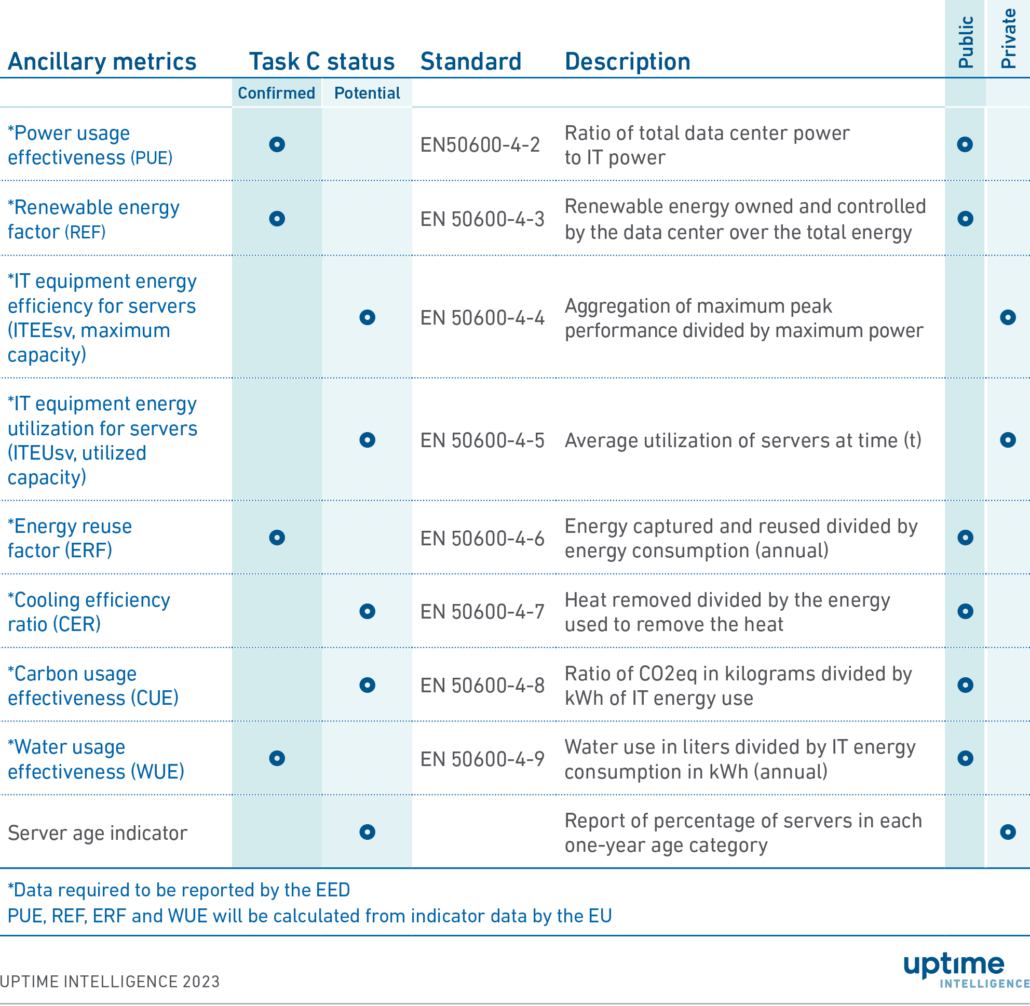
Public reporting of location-specific information
Table 5 lists the location-specific information that the EC recommends being made available to the public.
Table 5. The public reporting of indicator data and metrics
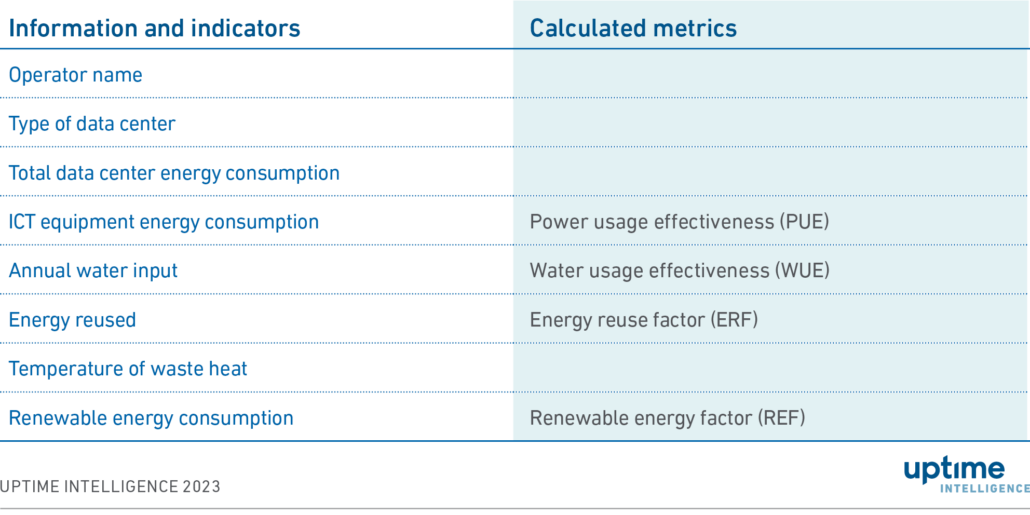
These data elements will reveal a significant level of detail about individual data center operations and will focus scrutiny on operators that are perceived as inefficient or using excessive quantities of energy or water. Operators are advised to look at their data from 2020 to 2022 for these elements. They will need to consider how the public will perceive the data, determine the appropriateness of creating an improvement plan and develop a communication strategy to engage with stakeholders the company’s management of its data center operations.
EU member states and EU-level reporting will provide aggregated data to detail the overall scope of data center operations in the individual jurisdictions.
Data center efficiency rating systems and thresholds
The Task B report looks at the variety of sources on which the EC has built its data center efficiency rating systems and thresholds. In particular, the report evaluates:
- A total of 25 national and regional laws, such as North Holland regional regulation.
- Voluntary initiatives, such as the European Code of Conduct for Energy Efficiency in Data Centres.
- Voluntary certification schemes, such as Germany’s Blauer Engel Data Centers ecolabel.
- Building-focused data center certification schemes, such as the Leadership in Energy and Environmental Design (LEED) and Building Research Establishment Environmental Assessment Method (BREEAM).
- Self-regulation, such as the Climate Neutral Data Center Pact.
- A maturity model for energy management and environmental sustainability (CLC/TS 50600-5-1).
The report distills this information into four of the most promising options.
- Minimum performance thresholds for PUE and REF. These could be based on current commitments, such as those by the Climate Neutral Data Center Pact, and government targets for minimum renewable energy consumption percentages.
- Information requirements in the form of a rating-based labeling system. This would likely be differentiated by data center type and redundancy level, and built on metric performance thresholds and best practices:
- Mandatory system. A multi-level rating system based on efficiency metric thresholds with a minimum number of energy management best practices.
- Voluntary system. Pass / fail performance criteria will likely be set for a mix of efficiency metrics and best practices for energy management.
- Information requirements in the form of metrics. Indicator data and metric performance results would be published annually, enabling stakeholders to assess year-to-year performance improvements.
Integrating the Task A through C reports, the EC appears poised to publish the performance indicator data and metrics calculations detailed in option 3 in the above list for the May 15, 2024 public report. The EC’s intent seems to be to collect sufficient data to assess the current values of the key metrics (see Table 4) at operating data centers and the performance variations resulting from different data center types and redundancy levels. This information will help the EC to select the best set of metrics with performance threshold values to compel operators to improve their environmental performance and the quantity of work delivered for each unit of energy and water consumption.
Unfortunately, the EC will have only the 2024 data reports available for analysis ahead of the second assessment’s deadline of May 15, 2025, when it will recommend further measures. The quality of the 2024 data is likely to be suspect due to the short time that operators will have had to collect, aggregate, and report this data. It would benefit the European Parliament and the EC to delay the second assessment report until March 2026.
This extension would enable an analysis of two years’ worth of data reports, give operators time to establish and stabilize their reporting processes, and the EC time to observe trends in the data to improve their recommendations.
Conclusion
The details of the EED data reporting requirements are slowly coming into focus with the publication of the draft Task B and Task C reports. There is the potential for some changes to both the final, approved EED and the final Task A to D reports that will be delivered to the European Parliament by the end of 2023, but they are likely to be minimal. The EED was approved by the European Parliament on July 11, 2023 and is scheduled for Council approval on July 27, 2023, with formal publication two to three weeks later.
The broad outline and most of the specifics of the required data reports are now clearly defined. Operators need to move quickly to ensure that they are collecting and validating the necessary data for the May 15, 2024 report.
A significant exception is the lack of clarity regarding the measurements and methodologies that IT operators can use to estimate their server work capacity and utilization. The data center industry and the EC need to develop, approve and make available the data sets and methodologies that can facilitate the calculation of these indicators.
The Uptime Intelligence View
The EC is quickly converging on the data and metrics that will be collected and reported for the May 15, 2024 report. The publicly reported, location-specific data will give the public an intimate view of data center resource consumption and its basic efficiency levels. More importantly, it will enable the EC to gather the data it needs to evaluate a work per energy metric and develop minimum performance thresholds that have the potential to alter an IT manager’s business goals and objectives toward a greater focus on environmental performance.


 2019, Getty
2019, Getty



 Getty
Getty


